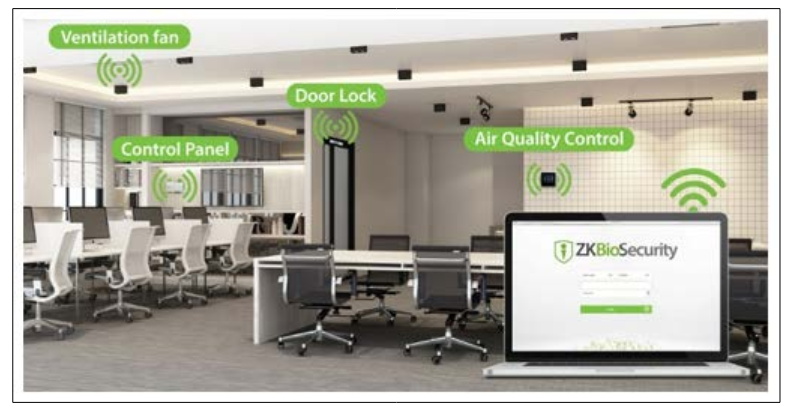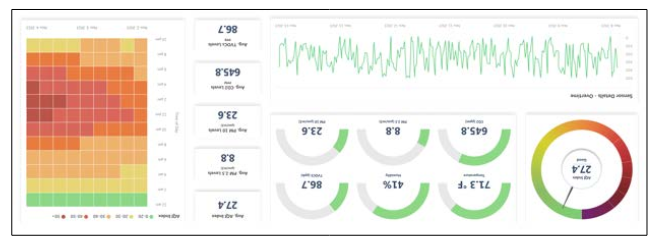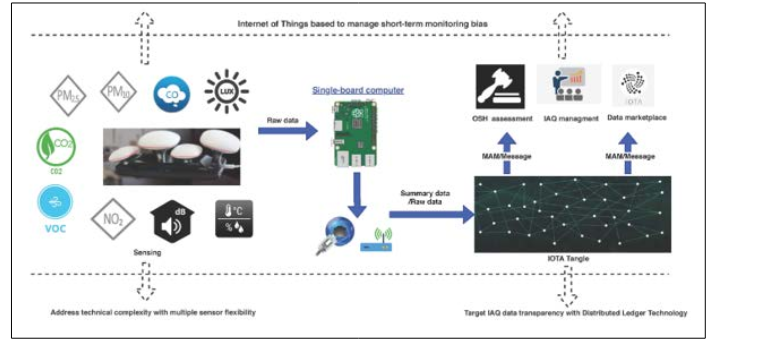Author(s): Vrushank Mistry
In response to the growing emphasis on healthier indoor environments and sustainable building practices, this research delves into the intricate relationship between building automation and key facets of indoor environmental quality. Specifically, the study focuses on the impact of building automation systems on Indoor Air Quality (IAQ) and the overall performance of Heating, Ventilation, and Air Conditioning (HVAC) systems. With the increasing demand for enhanced IAQ, building automation emerges as a crucial tool for real-time monitoring and optimization of various IAQ parameters. The research explores the comprehensive integration of automation technologies within building systems, elucidating their multifaceted effects on IAQ. By scrutinizing the intricate interplay between automation systems and HVAC components, the study unveils the ways in which automation technology influences and contributes to IAQ management. The investigation encompasses a thorough examination of sensor technologies, control algorithms, and data analytics employed in building automation to ensure a nuanced understanding of their impact on IAQ. Furthermore, the study elucidates the broader implications of building automation on HVAC system performance. It investigates how automated control mechanisms, coupled with real-time data analytics, contribute to the efficient operation of HVAC systems in maintaining optimal IAQ. The research contemplates the synergies between automation technologies and HVAC components, emphasizing their role in not only ensuring healthier indoor environments but also in achieving energy-efficient and sustainable HVAC operation
The burgeoning interest in creating indoor environments that are not only energy-efficient but also conducive to occupants' health and well-being has fueled the widespread adoption of building automation systems. Among the myriad factors shaping indoor environmental quality, Indoor Air Quality (IAQ) stands out as a critical determinant of occupant comfort and health. Concurrently, the intricate orchestration of Heating, Ventilation, and Air Conditioning (HVAC) systems plays a pivotal role in maintaining optimal IAQ.
This research embarks on a comprehensive exploration into the profound impact of building automation on IAQ and HVAC performance, delving into the intricate nexus between automation technologies and the key components of HVAC systems. In a world increasingly inclined toward sustainable building practices, the integration of smart technologies becomes paramount, with building automation emerging as a linchpin for achieving multifaceted objectives.
As the research unfolds, it navigates through the dynamic landscape of building automation, scrutinizing the deployment of advanced sensor technologies, sophisticated control algorithms, and realtime data analytics. These elements collectively form the backbone of building automation systems, enabling precise monitoring and optimization of IAQ parameters. By shedding light on the intricate interplay between automation systems and IAQ management, the study seeks to unravel the transformative potential of these technologies in fostering healthier indoor environments.
Simultaneously, the research investigates the broader implications of building automation on HVAC system performance. Automated control mechanisms, empowered by data-driven insights, not only contribute to maintaining optimal IAQ but also play a pivotal role in driving the energy efficiency and sustainability of HVAC operations. The integration of automation technologies into HVAC systems holds the promise of not only enhancing comfort but also aligning with the imperatives of environmentally conscious building practices.
In essence, this research sets out to demystify the symbiotic relationship between building automation, IAQ, and HVAC performance. By doing so, it aspires to contribute nuanced perspectives to the ongoing discourse on sustainable building practices and the pivotal role of automation technologies in shaping the indoor environments of the future.
Building automation plays a pivotal role in managing Heating, Ventilation, and Air Conditioning (HVAC) systems. The integration of BAS with HVAC systems offers several key benefits:
• Energy Efficiency: BAS optimizes HVAC system operation
by adjusting settings based on real-time data, occupancy
patterns, and external conditions. This ensures that energy is
used more efficiently, reducing overall consumption.
• Occupant Comfort: Automation allows for precise control
of indoor environmental conditions, such as temperature
and humidity, contributing to enhanced occupant comfort
and well-being.
• Remote Monitoring and Control: Building operators can
remotely monitor and control HVAC systems through the
BAS. This capability enables quick responses to faults,
efficient troubleshooting, and the implementation of energysaving measures.
• Data Analytics: BAS collects and analyzes data from HVAC
systems, providing valuable insights into performance trends,
equipment health, and opportunities for further optimization.
• Fault Detection and Diagnostics: Automation systems can
detect anomalies and faults in HVAC equipment, facilitating
proactive maintenance and minimizing downtime.
Indoor Air Quality (IAQ) is a critical aspect of building environments, influencing the health, comfort, and well-being of occupants. The significance of maintaining high IAQ in buildings can be highlighted through several key points:
• Occupant Health: IAQ directly affects the respiratory health
of building occupants. Poor air quality can lead to respiratory
issues, allergies, and other health problems, impacting the
overall well-being of individuals.
• Productivity: High IAQ is linked to improved cognitive
function and increased productivity. Clean and well-ventilated
indoor environments contribute to enhanced concentration
and mental clarity among building occupants.
• Comfort: Good IAQ provides a comfortable and pleasant
indoor environment. Proper temperature, humidity levels,
and the absence of pollutants contribute to occupant comfort,
making the space more enjoyable for living, working, or
leisure activities.
• Reduced Sick Building Syndrome (SBS): Buildings
with poor IAQ can contribute to Sick Building Syndrome,
characterized by symptoms such as headaches, fatigue, and
respiratory issues. Maintaining good IAQ helps mitigate the
occurrence of SBS.
• Legal and Regulatory Compliance: Many regions have
regulations and standards in place to ensure acceptable IAQ
levels in public and commercial buildings. Compliance with
these standards is essential for legal and regulatory reasons.
• Ventilation: Inadequate ventilation can lead to a buildup
of indoor pollutants. Proper ventilation systems ensure the
constant supply of fresh outdoor air, diluting and removing
contaminants.
• Airborne Pollutants: Common pollutants include particulate
matter, volatile organic compounds (VOCs), mold spores,
and bacteria. These pollutants can originate from building
materials, furniture, cleaning products, and outdoor sources.
• Humidity Levels: Excessive humidity can lead to mold
growth and the proliferation of dust mites, while low humidity
can cause discomfort and respiratory irritation. Maintaining
optimal humidity levels is crucial for IAQ.
• Occupant Activities: Human activities, such as cooking,
smoking, and the use of certain products, contribute to indoor air
pollution. Managing and controlling these activities impact IAQ.
• Building Materials and Furnishings: Materials used in
construction and furnishings can release VOCs, affecting
IAQ. Using low-emission materials and proper ventilation
helps mitigate these effects.
• Respiratory Issues: Poor IAQ is associated with respiratory
problems, including aggravated asthma, allergies, and
respiratory infections.
• Fatigue and Discomfort: Occupants in buildings with poor
IAQ may experience fatigue, discomfort, and difficulty
concentrating, leading to reduced productivity.
• Headaches and Dizziness: Exposure to pollutants can cause
headaches and dizziness, negatively impacting cognitive
function and overall well-being.
• Increased Sick Leave: Buildings with poor IAQ are often
linked to higher rates of sick leave among occupants due to
health-related issues.
• Cognitive Impairment: Studies have shown that exposure
to indoor pollutants can impair cognitive function, affecting
decision-making and problem-solving abilities.
Building Automation Systems (BAS) play a crucial role in improving Indoor Air Quality (IAQ) and optimizing the performance of Heating, Ventilation, and Air Conditioning (HVAC) systems. The integration of automation technologies offers a range of benefits that positively impact both IAQ and HVAC performance:
Building Automation Systems enable real-time monitoring and precise control of various IAQ parameters. Sensors integrated into the system continuously measure factors such as temperature, humidity, air circulation, and pollutant levels. This granular level of control allows for immediate responses to changes in IAQ, ensuring a consistently healthy indoor environment.
Automated HVAC systems, driven by BAS, optimize energy usage for heating, cooling, and ventilation. By dynamically adjusting system parameters based on real-time data and occupancy patterns, building automation ensures that energy is used efficiently. This results in significant cost savings for building owners and operators, as energy consumption is minimized without compromising IAQ or occupant comfort.
Building occupants experience improved comfort and well-being in environments where IAQ is effectively managed. Automated HVAC systems maintain optimal temperature and humidity levels, creating comfortable spaces that positively impact occupant satisfaction and productivity. Consistently comfortable indoor conditions, facilitated by building automation, contribute to a healthier and more productive workforce.
Building Automation Systems can implement adaptive ventilation strategies based on occupancy and IAQ conditions. This includes adjusting ventilation rates and introducing fresh outdoor air when needed, preventing the buildup of indoor pollutants. Adaptive strategies contribute to maintaining high IAQ while minimizing energy waste associated with unnecessary ventilation.
Automated monitoring allows for the early detection of IAQ issues, such as elevated pollutant levels or ventilation problems. BAS can trigger alarms or notifications, enabling facility managers to address problems promptly. Early intervention helps prevent IAQ-related health issues and ensures a proactive approach to maintaining optimal indoor conditions.
Building Automation Systems facilitate compliance with IAQ standards and regulations. By continuously monitoring and adjusting parameters, automated systems help ensure that indoor environments meet or exceed established IAQ guidelines. This is particularly important in settings where strict IAQ standards are mandated, such as healthcare facilities, schools, and commercial buildings.
The wealth of data generated by BAS provides valuable insights into IAQ and HVAC system performance. Facility managers can leverage this data for data-driven decision-making, identifying trends, optimizing system settings, and implementing long-term strategies for continuous improvement.
Introduction: Educational institutions prioritize the well-being of students and staff, and Indoor Air Quality (IAQ) is a crucial aspect of creating a conducive learning environment. This case study explores the successful implementation of a Building Automation System (BAS) to enhance IAQ in a local school.
Client Profile: The client, a progressive school district, recognized the significance of IAQ for student health, focus, and overall well-being. Concerned about rising ventilation challenges and varying IAQ conditions, they sought an innovative solution to ensure optimal air quality in their facilities.
Challenges: The school faced several challenges related to IAQ, including inconsistent ventilation, difficulty in monitoring air quality parameters, and the need for an energy-efficient solution. Traditional HVAC systems were proving insufficient in adapting to changing occupancy levels and external factors.
Solution: The implementation of a comprehensive Building Automation System (BAS) was proposed and executed to address the identified challenges. The system included:
Smart Ventilation Controls: Automated ventilation adjustments based on real-time occupancy data and outdoor air quality ensured optimal air exchange rates.
IAQ Sensors: Strategically placed IAQ sensors continuously monitored parameters such as CO2 levels, particulate matter, and humidity. This data was integrated into the BAS for realtime analysis.
Occupancy Sensors: Smart sensors were deployed to detect and respond to variations in room occupancy, enabling the system to adjust ventilation rates accordingly
Predictive Maintenance: The BAS incorporated machine learning algorithms to predict and schedule maintenance tasks for HVAC components, ensuring equipment efficiency and IAQ reliability.
Implementation: The BAS was seamlessly integrated with the existing HVAC infrastructure. The installation involved connecting sensors to the centralized control system, configuring automation rules, and implementing user-friendly interfaces for facility management.
Consistent IAQ: The BAS enabled a consistent and healthy IAQ by dynamically adjusting ventilation rates and responding to occupancy changes.
Energy Efficiency: Smart controls optimized energy consumption by aligning HVAC operations with actual demand, resulting in reduced energy costs.
Maintenance Cost Savings: Predictive maintenance reduced downtime and extended the lifespan of HVAC equipment, leading to significant cost savings.
Occupant Satisfaction: Improved IAQ positively impacted the well-being and focus of students and staff, contributing to an overall positive learning environment [1-14].

Figure 1: Real-Time Air Quality Monitoring Systems. Reference: ZKTECO Access Control

Figure 2: Improving Indoor Air Quality in Schools with Air Quality Monitoring: Introducing HibouAir | By HibouAir

Figure 3: Improving Indoor Air Quality in Schools with Air Quality Monitoring: Introducing HibouAir | By HibouAir

Figure 4: Indoor Air-Quality Data-Monitoring System
